

Employee Experience by Design: How to Create an Effective EX for Competitive Advantage (3 March 2021) by Emma Bridger and Belinda Gannaway. Redefining employee experience: How to create a “new normal” COVID-19 has swept through workplaces like a hurricane, scattering employees in every direction, exposing many to new risks, and redefining what workers need to do their jobs safely, efficiently, and effectively.
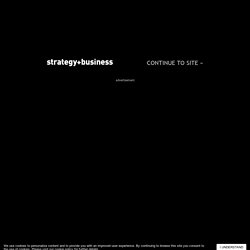
At the same time, customers’ needs and expectations have changed drastically, too. As interactions have moved online and economic pressure has made revenue a matter of brand survival, the touch points where the customer journey and employee journey intersect — moments when a brand can create (or lose) value — have become even more critical than they already were, both in ways that can easily be counted, such as revenue, and in ways that cannot, such as emotional connections. Related stories s+b Blogs As your focus as a business leader shifts from survival and resilience to recovery and the long-term health of your company, redesigning your employee experience (EX) will be paramount. 1. 2. 3.
On the difference between employee engagement and employee experience. To Overcome Vaccine Hesitancy, We Need a Better Patient Experience. Redesigning public-sector customer experiences for equity. Racial inequities in the United States have been well documented.
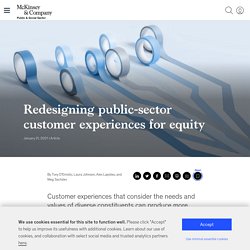
In 2016, the median white family had more than ten times the wealth of the median Black family. Black Americans have also been disproportionately affected by the COVID-19 pandemic, with higher rates of health and economic disruption. There continues to be evidence that these inequities are reflected in Americans’ experiences with public-sector services, which can also result in different outcomes. For example, a study conducted by the National Community Reinvestment Coalition found that 43 percent of the time, white applicants to the Paycheck Protection Program (PPP) received more favorable treatment than their Black counterparts. What Is the Difference Between Organizational Culture, the Employee Experience, and Employee Engagement?
Download the PDF of this Infographic.
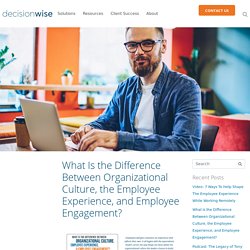
Employees will give customers an experience that reflects their own. It all begins with the expectations leaders set for the way things are done within the organizational culture the leaders choose to build. Organizational Culture Is What We Build It’s a set of values, norms, guiding beliefs, and understandings shared by members of an organization and taught to new members as the way to feel, think, and behave. Culture can be deliberate or organic. 6 Human Experience Management Trends in 2021. On demand webinar - Creating employee experience for the ‘new normal’ How to Use 360-Degree Feedback to Improve Your Employee Experience.
At DecisionWise, we spend a lot of our time helping organizations understand their employee experience, with the end-goal of improving an organization’s levels of employee engagement.
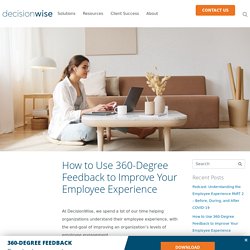
How Do We Measure the Employee Experience? Most often, we start by studying how things are working inside an organization from the employees’ perspective. Some of the tools we use include: Using the data we collect, we are able to paint a fairly detailed picture of what is happening within the overall employee experience, and we can tell if the employees are passionate, energetic, and committed to their work or if there are areas for improvement. Podcast: Understanding the Employee Experience PART 2 – Before, During, and After COVID-19. Reimagining the Employee Experience.
Infographic: The 3 Lenses of the Employee Experience - DecisionWise. Fonctionnement collectif : comment (re)mobiliser à partir de l'expérience récente ? Au lendemain de la crise sanitaire et du déconfinement, j’ai eu l'occasion d’interviewer des dirigeants d’entreprises en juin et juillet 2020.
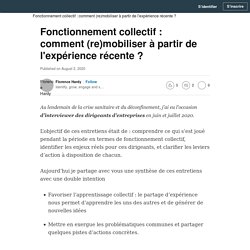
L’objectif de ces entretiens était de : comprendre ce qui s’est joué pendant la période en termes de fonctionnement collectif, identifier les enjeux réels pour ces dirigeants, et clarifier les leviers d’action à disposition de chacun. Aujourd’hui je partage avec vous une synthèse de ces entretiens avec une double intention Favoriser l’apprentissage collectif : le partage d’expérience nous permet d’apprendre les uns des autres et de générer de nouvelles idéesMettre en exergue les problématiques communes et partager quelques pistes d’actions concrètes.
Ce que j’ai entendu – ce qui a été mis en œuvre pour traverser la crise Le premier constat est évident et pourtant mérite d’être posé, parce qu’il conditionne le reste. Qui dit crise dit cellule de crise, « mode commando », décisions rapides sans attendre le consensus. Pourquoi ça marche ? Florence Hardy. Infographic: Experience Matters. The Employee Experience and the “Law of Congruent Experience” Creating a winning customer experience starts first with the Employee Experience.
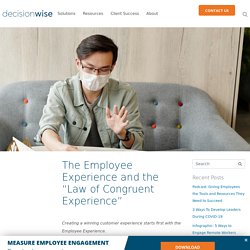
The customer. It’s any person or group receiving a service from an individual or organization. If you run a company, it’s the person buying your t-shirts, pizza, or software. In healthcare, it’s the patient. Eight Steps to Improving Employee Experience. What does it mean to be people-centered and how can this approach enhance the employee experience? A simple visual tool called the Employee Experience Journey Map can help you discover how to motivate teams and inspire an employee experience revolution!
For most people, working in a company is like having a holiday dinner at your in-law’s house. Outwardly, you’re smiling, but in private, you’d rather be celebrating elsewhere. The Puzzle of Improving Employee Experience. Reimagining the Post-2020 Employee Experience. We currently find ourselves living in rather suddenly altered times.
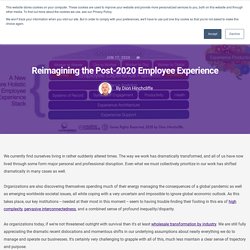
The way we work has dramatically transformed, and all of us have now lived through some form major personal and professional disruption. Even what we must collectively prioritize in our work has shifted dramatically in many cases as well. Organizations are also discovering themselves spending much of their energy managing the consequences of a global pandemic as well as emerging worldwide societal issues, all while coping with a very uncertain and impossible to ignore global economic outlook.
As this takes place, our key institutions -- needed at their most in this moment -- seem to having trouble finding their footing in this era of high complexity, pervasive interconnectedness, and a combined sense of profound inequality/disparity. As organizations today, if we're not threatened outright with survival then it's at least wholesale transformation by industry. COVID-19 and the employee experience. As it turns out, most companies did a solid job of addressing their employees’ basic needs of safety, stability, and security during the first phase of the COVID-19 crisis.
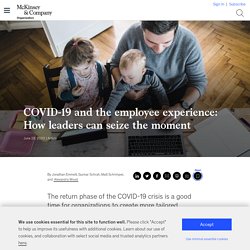
However, those needs are evolving, calling for a more sophisticated approach as organizations enter the next phase. McKinsey recently surveyed more than 800 US-based employees on a wide variety of topics related to employee experience. We found that employees working remotely see more positive effects on their daily work, are more engaged, and have a stronger sense of well-being than those in nonremote jobs with little flexibility do. Parents working from home appear to be faring better than those who are more isolated are. Employee Experience is the #1 Issue At Work - But Who Owns It? Why Employee Experience Initiatives Fall Short. Elevating customer experience excellence in the next normal.
This article was written collaboratively by the global leaders of the McKinsey Customer Experience Practice, a group that spans different regions and includes: Constance Emmanuelli, Nimish Jain, Nicolas Maechler, David Malfara, Stefan Moritz, Kevin Neher, Adrian Nelson, and Anna Thomas.
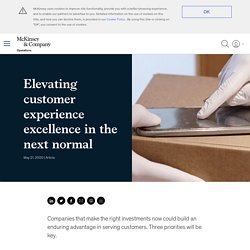
The impact of COVID-19 on customer behavior has been sweeping and immediate. Spending across most industries is down, purchases have shifted from in-person to digital channels, and public safety has become a top priority for companies and consumers alike. Executives who had carefully crafted omnichannel strategies to create unique, compelling customer experiences have had to throw out their playbooks and improvise to keep pace.
As companies prepare for the long haul—what we refer to as the “next normal”—the path forward is anything but clear. The situation continues to change by the week and can vary dramatically by region. Four ways to deliver better customer experience during the pandemic. Podcast - Why Employee Experience Matters in a Work from Home World with Trish McFarlane and Meg Bear. Featuring guests Trish McFarlane and Meg Bear with host Tamara McCleary Subscribe: Apple Podcasts | Stitcher | Google Play Employee experience has been an overlooked area of corporate development for most organizations.
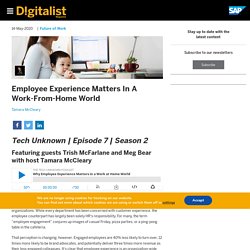
While every department has been concerned with customer experience, the employee counterpart has largely been solely HR’s responsibility. For many, the term “employee engagement” conjures up images of casual Friday, pizza parties, or a ping-pong table in the cafeteria. That perception is changing, however. As the current crisis redefines the way we work, keeping employees engaged is even more challenging – and even more crucial to an organization’s success. White Paper: The Manager’s Guide to Winning with the Employee Experience. Coronavirus How Will You Respond to this Defining Moment.
Just a few months ago, we polled senior HR leaders for Mercer’s 2020 Global Talent Trends, and found that employee experience topped the list of priorities for 2020. This was not surprising given the talent-led economy, where employers struggled with human capital challenges like attraction and retention. In just a few weeks’ time, however, the tables have turned. The escalation of COVID-19 into a pandemic — followed by a cascade of closures and stay-at-home orders — has sent stock markets crashing and unemployment rates skyrocketing. Companies are rapidly reprioritizing initiatives, and rightly so.
It’s easy, at a moment like this, to set employee experience (EX) aside as a “nice to have”— to be picked up again in more prosperous times. What Midsize Companies Should Know About The Customer Experience In Times Of Intense Change. By Maria Morais, Global Industries Director for Consumer Products, SAP Midsize businesses are known for understanding what customers want and meeting them where they are – in good and bad times. But what happens when a major event creates a wave of significant change that upends every aspect of our social infrastructure? Within weeks, we have evolved from a society that routinely gathers in large numbers, values physical togetherness, and has access to products and services on demand.
Six tips for making the digital customer experience more human in the time of COVID-19. Articles published in strategy+business do not necessarily represent the views of the member firms of the PwC network. Reviews and mentions of publications, products, or services do not constitute endorsement or recommendation for purchase. Six tips for making the digital customer experience more human in the time of COVID-19. Redefining customer experience: Connecting in the time of COVID-19. This column is the first in a series about redefining experiences in this time of great change and isolation, and reimagining them to emphasize the importance of human connection. All relationships have an emotional component — and that holds true for the connection between people and brands. Your business’s relationship with customers is built over time, nourished by experiences along many online and physical touchpoints in their journey, grounded in expectations, and confirmed through repeated interactions.
Related stories. Infographic: How Leaders Can Help Shape The Employee Experience in Times of Crisis. Download the PDF Version of the Infographic In today’s landscape, you may not be able to physically look an employee in the eye or put a supportive hand on a shoulder. But, with the willingness to adapt, there are plenty of other ways you can connect with and support your employees. Here are 7 ways to help shape the employee experience in times of crisis. Reinforce your Company Values FIND OUT how your team perceives the company values. Customer Experience ROI Research Report. Filling in the employee experience blanks. It is remarkable that the biggest questions facing employers today are less about what they sell, or even who they sell to, and more about how they are perceived. What matters in customer-experience transformations. Few debate the importance of customer experience, but companies still have trouble transforming their organizations to capture all the advantages of excellent customer experience.
While approaches vary based on the maturity of the business and the customer opportunities, the most-successful companies address three building blocks: aligning on a strong aspiration, implementing a disciplined process for transformation, and building up the enablers to make it all work (exhibit). We strive to provide individuals with disabilities equal access to our website. If you would like information about this content we will be happy to work with you. What Happens When Experience Management Is A Priority.
Many clients ask me how to stay relevant and win in the ever-changing landscape of the digital economy. The convergence of customer and employee experience. It’s amazing how the injection of competition can transform customer service. As soon as there’s choice, loyalty can no longer be taken for granted. As soon as people can take their custom elsewhere, brands must take stock. Suddenly, creating loyalty matters. The customer experience implications of the SARS-CoV-2 Coronavirus and COVID-19 Disease. The majority of organisations have a chief experience officer or chief customer officer: Gartner. Human experience platforms. As you enter the last leg of a long drive home, a network of cameras, microphones, and sensors embedded throughout your car monitors your facial expressions, voice, and the way you are using the car’s functionality.
Analyzing the inputs in real time, your car—using computer vision, voice recognition, and deep learning capabilities—determines that you are getting tired and distracted. In response, these AI-powered tools lower the thermostat and turn up the volume on the radio, and a conversational agent gently suggests you pull over or stop for a cup of coffee at a restaurant three miles ahead.1.
9 ways to improve the future of employee experience. The employer-employee psychological contract is changing. ROX3 From PwC: Boosting Returns On Leadership, Customer, And Employee Experiences. At one of the world’s most respected manufacturers — a company known for innovation and employee engagement — the CEO was asked recently about his greatest concerns about the enterprise.
“We lack leadership capacity,” he said. The company was entering an intensive phase in its quest to become digitally adept, seeking to master new technology, and it had not made enough progress in improving its employees’ skills or connecting with customers through digital channels. ROX3: Boosting returns on leadership, customer, and employee experience. Workshop Playbook: 9 Exercises to Spark CX Innovation. Experience Strategy. From customer experience to enterprise experience. Download the full report. 4 Ways To Keep CX Going When Uncertainty Looms. Part 4 of the “2020 Strategies and Insights for Midsize Companies” series. Growing Importance Of Customer Experience Management. How employee experience can drive transformation in 4 steps. Is Experience Management Exclusive To Consumers? Expérience employé : Le Manuel Indispensable. Human Experience Management (HXM): The Evolution Continues. Five Customer Experience Trends for 2020. The digital employee experience.
Employee Experience (EX): The Forgotten User Experience. How to build a great experience. Starbucks-experience-map. The Magic Of Enterprise Experience Strategy. How Do We Experience Awe? Beau Lotto Explains his Study on Cirque du Soleil for the TED Stage. Welcome To The Era Of ‘Human Experience Management’ Personal reflection on employee experience. Beau Lotto and Cirque du Soleil: How we experience awe. The Employee Experience 101: An Interview with IBM’s Benoit Hardy-Vallée. Measuring human relationships and experiences. Why Experience Management Is Essential For Your Organization. Employee Experience: Develop a Happy, Productive and Supported Workforce for Exceptional Individual and Business Performance (2019) by Ben Whitter. Engagement & The Employee Experience: Survey Report. How Your Manager Experience Shapes Your Employee Experience. Measuring human relationships and experiences.
Why Customer Experience Transformations Stall. The rise of the chief customer success officer. Lessons in Employee Experience. Transforming the Employee Experience at IBM. Why Every Company Needs a Chief Experience Officer. Create a competitive advantage through a more engaging people experience. Employee Experience – it’s time to get personal. ROX: How to get started with the new experience metric. Celebrate mindsets that value the customer AND the employee. How the Employee Experience Impacts Your Bottom Line—and What You Can Do to Improve. Does Your Employee Experience Strategy Improve Performance? Align Your Purpose, Brand and Culture for a Winning Employee Experience. Employee Experience vs. Engagement: What's the Difference? Align Your Purpose, Brand and Culture for a Winning Employee Experience. To Get Employees to Empathize with Customers, Make Them Think Like Customers. Customer Experience Tools and Trends 2018.